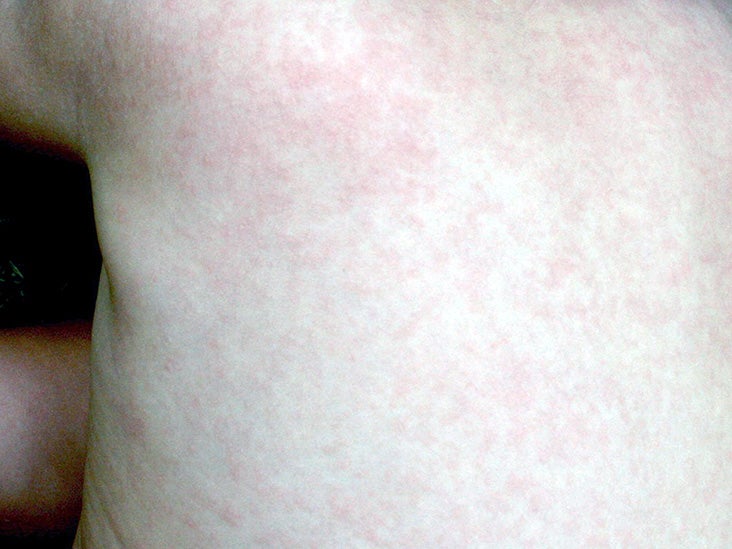Roseola rash: Pictures, symptoms, and treatments - Medical News Today

Roseola infantum is an infection caused by a type of herpes virus. It typically affects babies and toddlers.
Other names for this health issue are sixth disease, exanthema subitum, or just "roseola." Around 90% of roseola cases occur before 2 years of age.
Roseola results from infection with one of two main strains of the human herpesvirus (HHV): HHV-6 or HHV-7.
Below, we describe how to identify roseola and how to tell the difference between it and measles. We also look into whether treatment is necessary.
Roseola has a distinctive progression:
- A high fever develops, possibly suddenly, and may last for 3–5 days.
- A distinctive rash appears, usually on the torso, as the fever ends.
- The rash may spread to the neck, face, and limbs within 24 hours.
- The rash disappears after 1–2 days.
Roseola usually affects toddlers and babies under 2 years old. They may also have or show:
- general discomfort
- irritability
- an unwillingness to eat
- diarrhea
- a cough
- swelling or redness around the eyes
- inflamed eardrums
- swollen lymph nodes
The roseola rash may look like a raised, flat area of skin. Or, it may be raised patches of flat bumps that may merge together.
In some babies, the rash is reddish, and it may turn a lighter color when a person applies pressure. There can sometimes be a paler "halo" around the rash area.
The roseola rash does not usually cause pain, itchiness, or any blistering. It usually starts on the trunk of the body and can sometimes spread to the neck, face, arms, and legs.
About two-thirds of roseola cases also occur with Nagayama spots. These can be ulcers or papules that appear at the back of the mouth.
Roseola and measles both cause rashes and are common during childhood.
Measles can develop at any age, however, while roseola rarely affects adults. Find other important differences below.
Cause
Two strains of the herpes virus, HHV-6 or HHV-7, cause roseola. The virus multiplies in the salivary glands and saliva can transmit it to others.
The virus attaches to the salivary glands and brain tissue, remaining in the body after the baby or toddler recovers from roseola symptoms.
Measles, or rubeola, results from the measles virus. People transmit it through respiratory droplets and close contact. When the virus enters the body, it suppresses the immune response, and it can do so for up to several years.
Rash appearance
The roseola rash tends to appear as the fever is diminishing or after it has passed, which usually takes 3–5 days. The rash tends to appear on the torso and may spread to the face and limbs.
Children with measles, on the other hand, usually have a rash before a fever. Also, the measles rash starts on the face before spreading.
Complications
Children with roseola usually recover with no need for treatment from a doctor.
However, a high fever can be a common symptom of roseola, and it causes seizures in 10–15% of cases. This is the most common complication of the infection.
It is also worth noting that babies and toddlers with weakened immune systems tend to experience more severe symptoms of this infection.
Also, the virus can reactivate if the child's immune system is suppressed. As a result, children with cancer or who have had a transplant are more at risk of reactivation than other children.
Also, HHV-6 infection has been associated with:
People with measles often recover with no complications. However, some people develop hearing loss or pneumonia, and measles can lead to inflammation of the brain, which can be life-threatening.
The risk of complications is higher in children and babies under 5.
Prevention
There is currently no vaccine for roseola.
Measles, meanwhile, is a preventable illness with a very effective vaccine. The vaccine is given in two doses: one when a baby is 12–15 months old, and one when they are 4–5 years old.
There is no specific treatment for roseola. Over-the-counter pain relief medication such as acetaminophen (Tylenol) or ibuprofen (Advil) can usually control the fever. It is important to check the dosage carefully and be sure that it is appropriate for the baby or toddler.
Do not use aspirin without contacting a doctor, as it may cause Reye's syndrome in children, which can be deadly.
It is important to let the baby rest and make sure that they receive plenty of fluids. It is important to follow good hygiene, such as by washing the hands frequently, to prevent the infection from spreading.
It is important to seek medical attention right away if a baby has a high fever, a persistent rash, or both.
If there are signs of a febrile seizure — a seizure brought on by a high fever — seek immediate care.
Signs of a febrile seizure include:
- moaning
- rolling eyes
- vomiting or urinating
- convulsing, shaking, or twitching
- losing consciousness
A doctor can diagnose roseola by checking for symptoms and considering their medical history. They may also use a blood test to support the diagnosis.
Anyone with a compromised immune system who comes into contact with a child who has roseola should receive medical advice.
Roseola is an infection that typically affects babies and toddlers. It causes a high fever that lasts for 3–5 days, then a rash for a day or two. There is no specific treatment or vaccine.
The rash is very distinct, and it spreads in a characteristic pattern, starting from the torso.
Usually, roseola will resolve within about a week. An age-appropriate dosage of ibuprofen (Advil) or acetaminophen (Tylenol) can usually reduce the fever.
Comments
Post a Comment